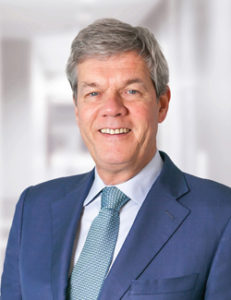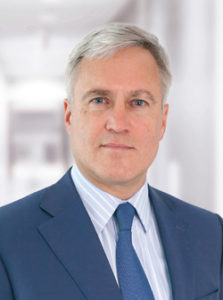Dick Boer and Frans Muller of Ahold Delhaize
ZAANDAM, Netherlands — The merger of Royal Ahold and the Delhaize Group always had a compelling logic behind it. The companies, with roots in the neighboring countries of Holland and Belgium, possessed complementary capabilities and geographic footprints, in both the European and American retail markets, as well as similar histories. Over the years, a variety of reasons prevented the deal from occurring, until Dick Boer and Frans Muller, determined leaders with an eye toward the future, succeeded in bringing the two companies together.

Dick Boer
“The merger had always been in the stars,” says Boer, who was Ahold’s chief executive officer for six years prior to completion of the deal last July and now holds the same job at Ahold Delhaize. “Both companies went through some difficult and different phases over the past decade, but we emerged from that transformation process in a much stronger condition, which made it possible for us to undertake a great journey together.”
Muller, formerly president and CEO of Delhaize and now deputy CEO and chief integration officer at the combined company, enumerates some of the factors that give management confidence: “Our businesses, which primarily involve supermarkets, are very comparable. We are both very strong in fresh and private label, for example, and we are committed to a sustainable model. We also have a strong e-commerce heritage on the one side, which is helping the group as a whole. In many ways we have a common language, which makes understanding each other’s opportunities better, in terms not only of synergies but also finding what’s new for us, and what we can learn from this experience.”

Frans Muller
For paving the way for the creation of a top-10 global retailer and the work they’ve initiated to make the new Ahold Delhaize greater than the sum of its parts, the editors of MMR have named Boer and Muller the publication’s Retailers of the Year.
Known as Better Together, the strategy put in place by the two executives is designed to harness the power of local brands with a meaningful heritage in the markets they serve, while giving them access to the resources of Ahold Delhaize’s global network. It is a vast undertaking. The company’s operations include 6,500 stores under 21 banners on three continents, which generate annual sales of some 61 billion euros. While supermarkets predominate, the vast retail empire includes convenience stores, online delivery, pickup points, hypermarkets, specialty stores and gasoline stations.
Ahold Delhaize’s geographic reach stretches across Europe — through the Netherlands and Belgium to the Czech Republic, Serbia, Romania and Greece, with joint ventures in Portugal and in Indonesia. In the United States, which accounts for about 60% of total sales, Ahold Delhaize has a dominant presence on the East Coast, where it operates 2,000 food stores under the Stop & Shop, Giant, Food Lion, Hannaford and Martin’s banners. It also runs Peapod, a leading online grocer, and bFresh, a new format that specializes in fresh and organic food.
In the period leading to the merger and the months since it was finalized, Boer and Muller have established a framework within which those diverse, far-flung businesses, along with the 375,000 employees who make them function, can innovate and flourish.
“What we did together with our leadership team was start working on developing our view of the world and deciding where we want to go as a company,” Boer recalls. “We created a new language for both companies, without losing touch completely with what each of us did in the past. But, in a real way, we rewrote our view of the future. The result is a clear and simple purpose — together we build great local brands, bringing fresh inspiration every day — and that gives guidance to the whole of the world of Ahold Delhaize.”
That vision is beginning to resonate. When the company’s top 350 leaders from around the world met in Washington, D.C., in October, they greeted the blueprint enthusiastically. Members of that group are now disseminating the strategy throughout the organization.
“This is a very rich soil we have to grow on,” says Muller. “That’s why we once more reconfirmed the idea of great local brands. It’s your store around the corner, and you couldn’t care less that we have 6,499 more of them, because you go to that single store. That’s why we very much believe in the local strength of our performance.”
The concept of fresh, applied in different ways to disciplines across the Ahold Delhaize network, is central to the strategy.
“Words like fresh resonate back to fresh produce, meats and seafood,” says Boer. “It’s a supermarket-owned territory in a very basic sense.
“But it’s also all about the fresh inspiration we provide in a new world of shopping. How can we work with the online piece? How do we work with our customers in an omnichannel world? So the idea of fresh inspiration guides the company and gives a direction to our people. That’s what the framework is doing for us. It helps us to guide all the brands and start applying it back.
“We expect all of our brands to pursue our overall objectives — be affordable for all, everywhere; offer fresher and healthier options; provide personalized service; buy better; and operate more efficiently with less waste — although they may do so in different ways. Achieving those goals will drive business and let us invest back into our customer propositions.”
Ongoing innovation is another aspect of fresh inspiration, adds Muller, citing the deployment of self-checkout technology as an example. “Customers expect that we will get better every day. So whether it’s a small or a big change, a small or a big evolution, it all adds up.”
The intense focus on building strong local brands and winning the allegiance of consumers store by store hasn’t caused Ahold Delhaize to underestimate the importance of scale. The company, which holds the No. 1 or No. 2 share in all of the markets where it does business, is intent on leveraging it size and global reach to achieve a projected 500 million in synergy savings by 2019; pool capabilities in disciplines where it makes sense, including finance, human resources and technology; and share best practices.
“To put it simply, we would like to differentiate on the customer-facing side of the business, and we would like to create synergies wherever we can on the back end,” says Muller, adding that Ahold Delhaize’s new corporate governance structure was in place on day one, and that the integration of the company’s global and European Union support centers has been completed. “To do that effectively, skill comes into the game, but also experience.
“Our brands can learn from one another. If you talk about the U.S., for example, we talk with our suppliers about how to make sure that we harmonize our conditions.
“There are a lot of opportunities — on the IT front, on the supply chain front, on the vendor front, on the cost front — to find synergies. When our work in those areas is paying off, we can invest more in customers and in communities. That’s what we would like to achieve.”
Striking the right balance between centralization and local autonomy is a difficult task, but management is convinced it is the best way to unleash the entrepreneurial talent of Ahold Delhaize’s workforce and meet the evolving needs of shoppers around the world. As a result of the merger, the expectation is that the strengths of the combined company will, over time, bring about a subtle change in perception on the part of customers.
“It is our hope that they realize some improvements have been made, but they don’t necessarily know the reason behind them,” says Boer. “For instance, you could think about the digital and e-commerce solutions we have. We take care of these types of things on a global level. We talk about them, and we see how we can quickly share ideas and implement them across our different markets.
“Or think about the fresh supply chain. How can we leverage our skills to improve it together with our partners? Scale is important when it comes to buying smarter in private label and developing owned brands. We need to have the volume and the quality on a level that it can be used in all of our markets.”
The promise embedded in Ahold Delhaize’s strategic framework to provide a better place to shop every day extends to two other key areas — offering a better place to work and being a better neighbor. Prior to the merger, both Ahold and Delhaize ranked high in the Dow Jones Sustainability Index, and the combined company is determined to build on that legacy.
“Expectations of how we deliver our business have changed — among our customers and the people that make up Ahold Delhaize itself,” Muller notes. “Our associates would like to work for a company that always acts responsibly — whether it’s sourcing seafood and other products in a sustainable way, doing what we can to reduce levels of obesity and diabetes, or operating in a way that’s good for the environment. People would like to make sure that they work for a company that has these types of priorities high on their list.
“How you run your business matters. As a business of our size, we have a responsibility to be a leader in taking these kinds of things very seriously. The nice thing about sustainability — if you talk about energy, if you talk about packaging, if you talk about food waste — is that, in 80% of the cases, a more sustainable business environment is also more cost efficient.”
The complexities of running a major retail business, especially one still in the early stages of the post-merger assimilation process, are greater than they’ve ever been. But Ahold Delhaize’s leadership has shown it has what it takes to master them.
“Personally, I find it much more interesting nowadays with all these issues where you can touch the world,” says Boer, whose father owned an independent grocery store near the Belgian border when he was growing up. “We have a great opportunity for our customers to save money and to be healthier, as well as to help save the planet and be more sustainable, while still working on good products. That’s more fun than 35 or 40 years ago, I can tell you.”




You must be logged in to post a comment Login